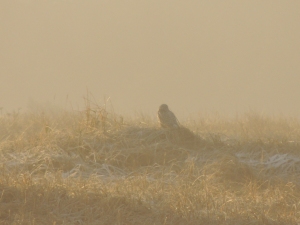A brisk wind swept over the spit and our eyes teared up as we tried to catch a glimpse of whatever was out there through the white-caps. The first bird over the waves was, surprisingly, a Peregrine Falcon. It was after a hot murrelet meal on a cold morning. Murrelets, murres and a Cassin’s Auklet swept through the chop with Long-tailed Ducks and scoters. Thirty-five Bald Eagles sat on the dunes and among the drift logs on the crown were scraps of Styrofoam and plastic bottles, probably Tsunami debris which we left alone.
A Song Sparrow hopped happily around us feeding on sand-fleas. It was a bare and isolated patch of beach for such a small bird, but it seemed oblivious and gradually moved inland. A flock of 158 Sanderlings were the only shorebirds on the beach and when we checked offshore again among the gulls and grebes were thirteen Sooty Shearwaters, two Northern Fulmars and five Short-tailed Shearwaters soaring in the distance! The Glaucous-winged, Mew, Thayer’s and Herring Gulls were joined by one Western and one Glaucous Gull. There were a few Red Crossbills at the base of the Spit, twenty-nine Song Sparrows and seven Fox Sparrows. No nuthatches this year but Golden-crowned Kinglets and Varied Thrushes joined the chickadees and Pacific Wrens in the thickets of low spruce.
East beach has changed radically. Dune erosion is severe and sand-ponds have appeared where once dune grasses waved in the wind. It makes for tricky, treacherous travel. On our return we stopped at Yakan Point to count the cormorants (103) and in the mix was one Red-faced Cormorant, dark brown, not black, preening in the centre of the flock. A rare find indeed. Total species count 51; with 1293 individuals.

